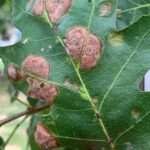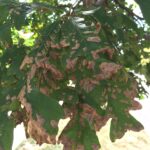Oak Leaf Blister
Oak Leaf Blister is a fungal disease that affects the leaves of oak trees. It is caused by the fungus Taphrina caerulescens and is most commonly found in the eastern United States. The disease is most prevalent in wet springs, as the fungus requires moisture to germinate and infect the tree.
Symptoms of Oak Leaf Blister typically appear in mid to late spring, when the new leaves are emerging. Infected leaves have raised, blister-like areas on the upper surface that are yellowish-green to yellowish-brown in color. The blisters can range in size from 1/8 inch to 1/2 inch in diameter and are often surrounded by a reddish halo. As the blisters age, they become brown and dry up, leaving a tattered appearance on the leaf.
Oak Leaf Blister does not typically cause significant damage to the tree, and infected trees will usually produce a second flush of leaves later in the season that are not infected. However, severe infections can cause defoliation, which can weaken the tree and make it more susceptible to other diseases and pests.
Management of Oak Leaf Blister involves maintaining good tree health and sanitation practices. This includes watering the tree during dry periods, avoiding overhead irrigation, and cleaning up fallen leaves and debris around the tree to reduce overwintering fungal spores. Fungicides may also be used in severe cases, but are not typically necessary for healthy trees.
Prevention of Oak Leaf Blister can be achieved by planting resistant oak species, such as bur oak, chinkapin oak, or white oak. These species are less susceptible to the disease and can be a good alternative to other oak species that are more susceptible, such as pin oak or red oak.




